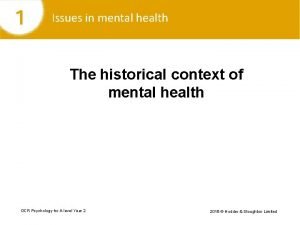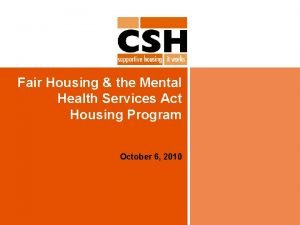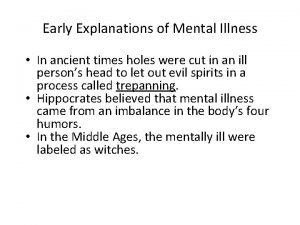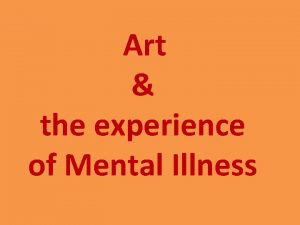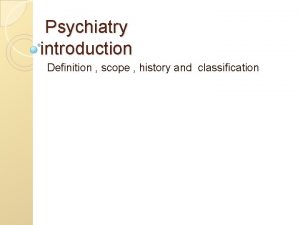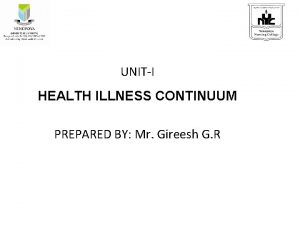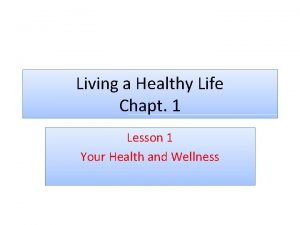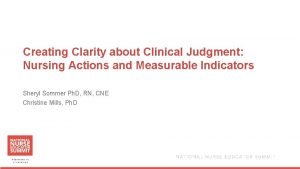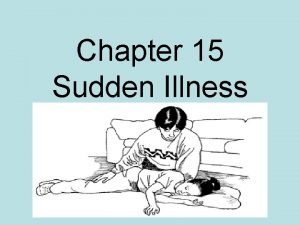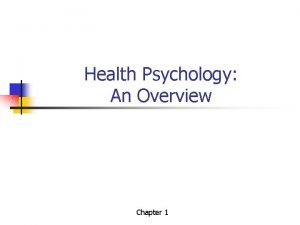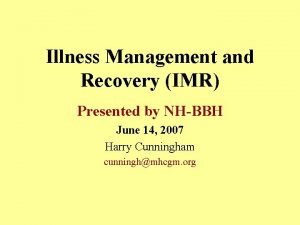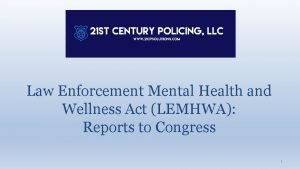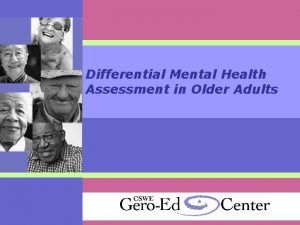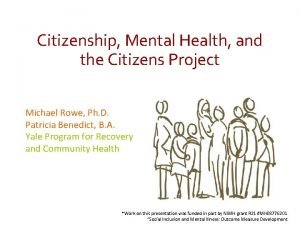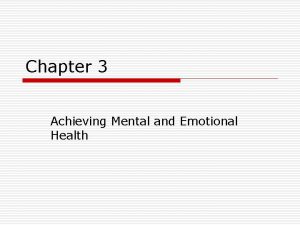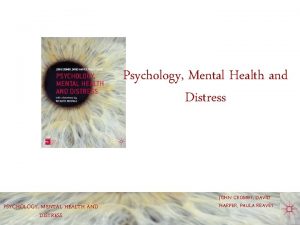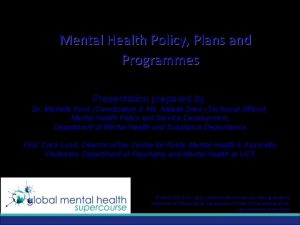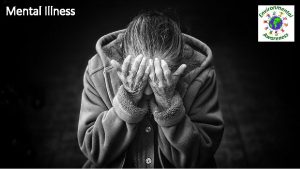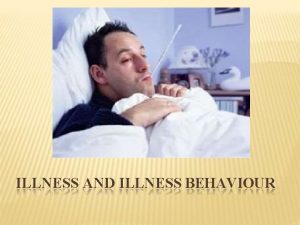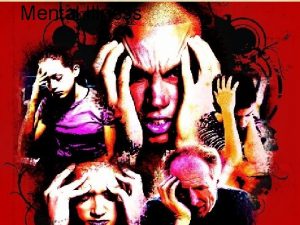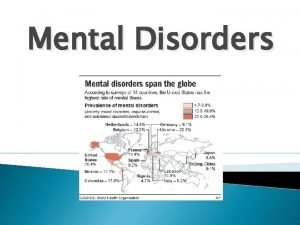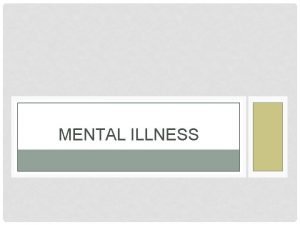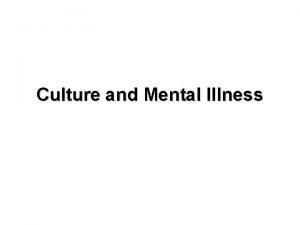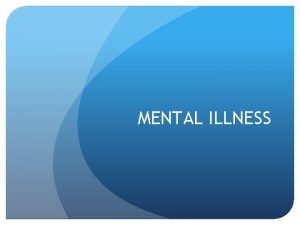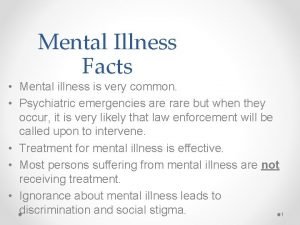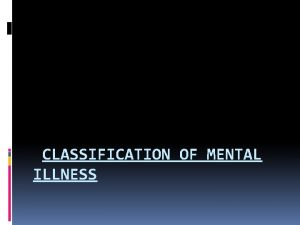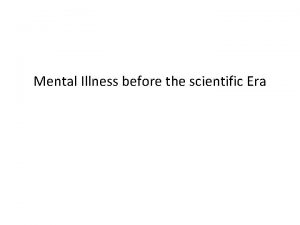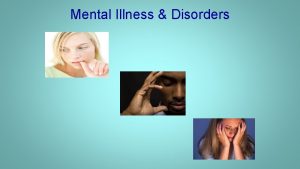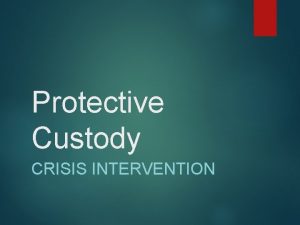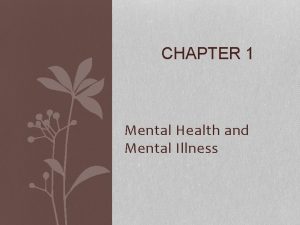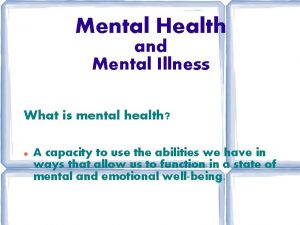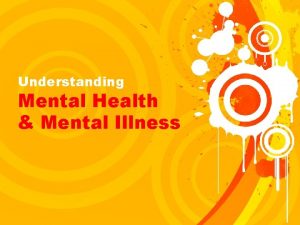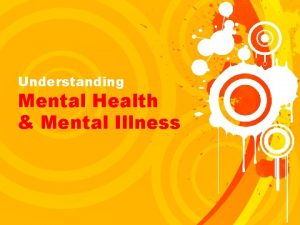20 Mental Health and Mental Illness 1 Identify




























- Slides: 28

20 Mental Health and Mental Illness 1. Identify seven characteristics of mental health Define the following term: mental health the normal functioning of emotional and intellectual abilities.

20 Mental Health and Mental Illness 1. Identify seven characteristics of mental health These are the characteristics of a person who is mentally healthy: • Gets along with others • Adapts to change • Cares for self and others • Gives and accepts love • Deals with situations that cause anxiety, disappointment, and frustration • Takes responsibility for decisions, feelings, and actions • Controls and fulfills desires and impulses appropriately

20 Mental Health and Mental Illness 2. Identify four causes of mental illness Define the following terms: mental illness a disease that affects a person’s ability to function at a normal level in the family, home, or community. situation response a temporary condition that has symptoms like those of mental illness; possible causes include a personal crisis, temporary physical changes in the brain, side effects from medications, interactions among medications, and severe change in the environment.

20 Mental Health and Mental Illness 2. Identify four causes of mental illness The following conditions may cause or worsen mental illness: • Physical factors such as illness, disability, aging, substance abuse, or chemical imbalance • Environmental factors such as weak family relationships or traumatic childhood experiences • Heredity or family influence • Stress, including coping abilities

20 Mental Health and Mental Illness 3. Distinguish between fact and fallacy concerning mental illness Define the following term: fallacy a false belief.

20 Mental Health and Mental Illness 3. Distinguish between fact and fallacy concerning mental illness REMEMBER: Mental illness is a disease like any other physical illness. People who are mentally ill cannot simply choose to be well.

20 Mental Health and Mental Illness 3. Distinguish between fact and fallacy concerning mental illness REMEMBER: Mental illness and intellectual disability are not the same. Intellectual disability is a developmental disability that causes below-average mental functioning. It is not a type of mental illness. One common point, however, is that residents with both conditions will need emotional support in addition to care and treatment.

20 Mental Health and Mental Illness 4. Explain the connection between mental and physical wellness REMEMBER: Being mentally healthy can reduce stress and prevent some physical diseases. The reverse of this statement is also true. Mentally ill residents may experience high levels of stress that can affect their physical health.

20 Mental Health and Mental Illness 4. Explain the connection between mental and physical wellness Think about this question: What stress-reducing techniques do you find effective in your own life?

20 Mental Health and Mental Illness 5. List guidelines for communicating with mentally ill residents NAs should remember these guidelines for communicating with residents who are mentally ill: • Do not talk to adults as if they were children. • Use simple, clear statements and normal tone of voice. • Communicate respect and concern. • Sit or stand at a normal distance. Use posture that says you are listening (body language). • Be honest and direct. • Avoid arguments. • Maintain eye contact. • Listen carefully.

20 Mental Health and Mental Illness 6. Identify and define common defense mechanisms Define the following term: defense mechanisms unconscious behaviors used to release tension or cope with stress.

20 Mental Health and Mental Illness 6. Identify and define common defense mechanisms NAs should be familiar with these defense mechanisms: • Denial • Projection • Displacement • Rationalization • Repression • Regression

20 Mental Health and Mental Illness 7. Describe the symptoms of anxiety, depression, and schizophrenia Define the following terms: anxiety uneasiness or fear, often about a situation or condition. phobias an intense form of anxiety or fear. claustrophobia the fear of being in a confined space. panic disorder a disorder in which a person has repeated episodes of intense fear that something bad will occur.

20 Mental Health and Mental Illness 7. Describe the symptoms of anxiety, depression, and schizophrenia Define the following terms: obsessive-compulsive disorder (OCD) an anxiety disorder characterized by obsessive behavior or thoughts. post-traumatic stress disorder an anxiety disorder caused by a traumatic experience. apathy a lack of interest in activities. major depressive disorder a type of depression that causes withdrawal, lack of energy, and loss of interest in activities, as well as other symptoms; also called major depression.

20 Mental Health and Mental Illness 7. Describe the symptoms of anxiety, depression, and schizophrenia Define the following terms: bipolar disorder a type of depression that causes a person to swing from periods of deep depression to periods of extreme activity; also called manic-depressive illness. schizophrenia a form of mental illness that affects a person’s ability to think, communicate, make decisions, and understand reality. paranoid schizophrenia a form of mental illness characterized by hallucinations and delusions.

20 Mental Health and Mental Illness Transparency 20 -1: Mental Diagnosis 1

20 Mental Health and Mental Illness Transparency 20 -2: Mental Diagnosis 2

20 Mental Health and Mental Illness Transparency 20 -3: Mental Diagnosis 3

20 Mental Health and Mental Illness 8. Explain how mental illness is treated Define the following term: psychotherapy a method of treating mental illness that involves talking about one’s problems with mental health professionals.

20 Mental Health and Mental Illness 8. Explain how mental illness is treated Mental illness can be treated. The following are common treatments: • Medication • Psychotherapy

20 Mental Health and Mental Illness 8. Explain how mental illness is treated REMEMBER: Residents with mental illness have the right to participate in the planning of their care.

20 Mental Health and Mental Illness Transparency 20 -4: NA’s Role in Caring for the Mentally Ill • Observe residents carefully for changes. Document and report. • Support the resident and family. • Encourage residents to do as much for themselves as possible.

20 Mental Health and Mental Illness 10. Identify important observations that should be made and reported NAs should observe and report the following in residents with mental illness: • Changes in ability • Positive or negative mood changes (withdrawal) • Behavior changes • Comments about hurting self or others (including jokes) • Real or imagined physical symptoms • Events, situations, or people that provoke certain reactions

20 Mental Health and Mental Illness 11. List the signs of substance abuse Define the following term: substance abuse the repeated use of legal or illegal drugs, cigarettes, or alcohol in a way that is harmful to oneself or others.

20 Mental Health and Mental Illness Transparency 20 -5: Signs of Substance Abuse • Changes in physical appearance (red eyes, dilated pupils, weight loss) • Changes in personality (moodiness, strange behavior, disruption of routines, lying) • Irritability • Odor of cigarettes, liquor, or other substances on breath or clothes • Diminished sense of smell • Unexplained changes in vital signs • Loss of appetite • Inability to function normally • Need for money • Confusion or forgetfulness • Blackouts or memory loss • Frequent accidents • Problems with family or friends

20 Mental Health and Mental Illness 11. List the signs of substance abuse REMEMBER: Illegal drugs are not the only substances that are abused. Overthe-counter and prescription medications can be abused if taken incorrectly or excessively.

20 Mental Health and Mental Illness 11. List the signs of substance abuse Think about this question: What substances commonly found in the home could be abused?

20 Mental Health and Mental Illness 11. List the signs of substance abuse REMEMBER: Residents who do not have doctors’ orders against drinking alcohol and who live in a facility where alcoholic beverages are allowed may drink alcohol if they wish to do so. NAs should not make judgments or gossip.
 Mental health and mental illness chapter 20
Mental health and mental illness chapter 20 Mental health jeopardy
Mental health jeopardy Historical views of mental illness psychology ocr
Historical views of mental illness psychology ocr Fair housing act mental illness
Fair housing act mental illness Mental illness in ancient times
Mental illness in ancient times Personality disorder vs mental illness
Personality disorder vs mental illness Mark rothko mental illness
Mark rothko mental illness Catherine earnshaw mental illness
Catherine earnshaw mental illness Americanization of mental illness
Americanization of mental illness Derealiation
Derealiation Ksi mental illness
Ksi mental illness Health illness continuum model
Health illness continuum model Health illness continuum
Health illness continuum Continuum of health
Continuum of health Clinical judgement sample items a ati
Clinical judgement sample items a ati Sudden illness examples
Sudden illness examples Illness and wellness continuum
Illness and wellness continuum Illness management and recovery worksheet
Illness management and recovery worksheet Health and social component 3
Health and social component 3 Chapter 3 achieving mental and emotional health answer key
Chapter 3 achieving mental and emotional health answer key Mental health and older adults
Mental health and older adults Law enforcement mental health and wellness act
Law enforcement mental health and wellness act Mental health and older adults
Mental health and older adults Mental health and citizenship
Mental health and citizenship Chapter 3 achieving mental and emotional health
Chapter 3 achieving mental and emotional health Chapter 21 mental health diseases and disorders
Chapter 21 mental health diseases and disorders Chapter 15 achieving mental and emotional health answer key
Chapter 15 achieving mental and emotional health answer key Psychology, mental health and distress
Psychology, mental health and distress Mental health policy, plans and programmes michelle funk
Mental health policy, plans and programmes michelle funk


